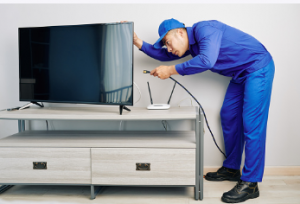You might have heard of the cost of hiring a professional to install your TV antenna. While you may have the right tools and the correct fixings, you may not have the right safety gear or the knowledge of electrical regulations. A professional installer will also have the correct tools and knowledge of the regulations in your area. Read on to find out how to install a TV antenna and why you should consider hiring a professional.
 Cost of hiring a professional
Cost of hiring a professional
Hiring a professional to install a TV antenna has its advantages. Not only is it more convenient, but it will also guarantee a proper installation. If you’re attempting to install your antenna, there are several things you need to consider. For instance, outdoor or rooftop work is a major safety concern. While you may think you’re a handyman, you’ll need to be cautious as there is a risk of falling. In addition, a professional will have the right tools and knowledge of local laws and regulations.
To find a good installer, search for reviews online or ask your friends and family for recommendations. Check the credentials and reviews of each installer before hiring them. You can also compare prices and perks. Most companies will offer free estimates. Ultimately, you should hire a professional only if you’re satisfied with their work and are unsure of your technical abilities. However, it’s worth taking a few precautions before hiring an antenna installer.
Safety of installing a TV antenna on a ladder
The safety of TV antenna installation on a ladder can be affected by several factors. For example, an antenna on a roof is significantly larger than on a ground-level floor. Therefore, an important safety precaution for a ladder used for this task is to ensure that it has a wide base and strong anti-slip rungs. In addition, the antenna should be mounted at a 70-degree angle, and the ladder should dry properly before installation begins.
TV antenna installation is a dangerous project and should only be done by trained, experienced workers. It is also dangerous if it is located too close to power lines. To minimise the risk of electrical shock, you should be wearing rubber-soled boots and flexible protective gloves. To avoid potential electrical shock, be trained in first aid for electric shock. Finally, always read the instructions before you begin the job.
Getting good reception from a TV antenna
If your TV antenna isn’t providing good reception, you’re not alone. Many consumers have encountered reception issues, and manufacturers often provide little guidance and no troubleshooting steps. The antenna is just one of many connected devices that can interfere with signal reception. Engineers call these single points of failure. Here are a few tips for troubleshooting reception problems with your TV antenna. First, test the signal. A signal combiner can correct the problem if it’s poor or unusable.
Make sure the antenna faces the broadcast tower. A TV antenna placed near a window will provide a better broadcast signal. It’s also best to place the antenna near a window, so it has a clear line of sight to the broadcast tower. The antenna should be placed in the room where the television will be. While you’re at it, reorient the antenna if necessary. Remember to orient the antenna if you have a digital video recorder.
Mounting a TV antenna on a mast
A tripod mount is a lightweight, self-supporting structure mounted on a building’s roof. It is ideal for small vertical antennas and dishes, but larger ones need a mast more than 10 feet high. Tripod mounts come in various styles, and some are even made for temporary installations. Regardless of the type of antenna mount you need, there are several sources for these accessories.
Signal-level meter
A signal-level meter is extremely helpful when choosing an antenna, especially if you have no idea what it is. You can use it to measure the strength of the signal coming from your antenna, which can tell you if the signal is weak or strong. It is also useful for finding where you are likely to have poor signal reception. You can get an idea of the best direction by using your intuition and aligning the antenna with the direction of the television transmitter.